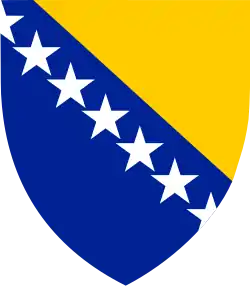Gradiška, Bosnia and Herzegovina
Gradiška (Serbian Cyrillic: Градишка),[1][2][3] formerly Bosanska Gradiška (Serbian Cyrillic: Босанска Градишка), is a city and municipality located in the northwestern region of Republika Srpska, the entity of Bosnia and Herzegovina. As of 2013, it has a population of 51,727 inhabitants, while the city of Gradiška has a population of 14,368 inhabitants.
Gradiška
| |
|---|---|
| Grad Gradiška
Град Градишка City of Gradiška | |
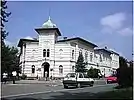 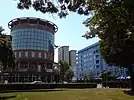 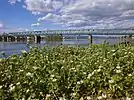 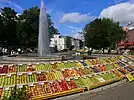  City of Gradiška | |
 Flag 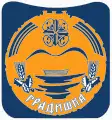 Coat of arms | |
 Location of Gradiška within Republika Srpska | |
 | |
| Coordinates: 45°08′45″N 17°15′14″E | |
| Country | |
| Entity | |
| Geographical region | Bosanska Krajina |
| Government | |
| • Mayor | Zoran Adžić (SNSD) |
| • City | 761.74 km2 (294.11 sq mi) |
| Elevation | 163 m (535 ft) |
| Population (2013 census) | |
| • City | 51,727 |
| Time zone | UTC+1 (CET) |
| • Summer (DST) | UTC+2 (CEST) |
| Postal code | 78400 |
| Area code | +387 51 |
| Website | www |
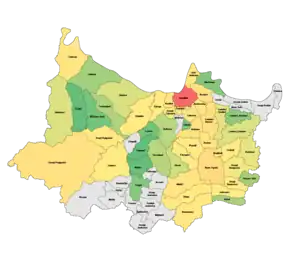
It is geographically located in eastern Krajina region, and the town is situated on the Lijevče plain, on the right bank of the Sava river across from Stara Gradiška, Croatia, and about 40 km (25 mi) north of Banja Luka.
History
In the Roman period this town was of strategic importance; a port of the Roman fleet was situated here. Among notable archaeological findings are a viaduct.
Gradiški Brod is mentioned for the first time as a town in c. 1330. It had a major importance as the location where the Sava river used to be crossed. By 1537, the town and its surroundings came under Ottoman rule.
The Ottoman built a fortress, which served as the Bosnia Eyalet's northern defense line. The town was also called Berbir because of the fortress.
Following the outbreak of the First Serbian Uprising (1804), in the Sanjak of Smederevo (modern Central Serbia), the Jančić's Revolt broke out in the Gradiška region against the Ottoman government in the Bosnia Eyalet, following the erosion of the economic, national and religious rights of Serbs. Hajduks also arrived from Serbia, and were especially active on the Kozara. Jovan Jančić Sarajlija organized the uprising with help from Metropolitan Benedikt Kraljević. The peasants took up arms on 23 September 1809, in the region of Gradiška, beginning from Mašići. The fighting began on 25 September, and on the same night, the Ottomans captured and executed Jančić. The rebels retreated to their villages, except those in Kozara and Motajica who continued, and offered strong resistance until their defeat in mid-October, after extensive looting and burning of villages by the Ottomans.[4] Another revolt broke out in 1834, in Mašići.[5]
Ottoman rule ended with the Austro-Hungarian occupation of Bosnia and Herzegovina (1878), following the Herzegovina Uprising (1875–77). Austro-Hungarian rule in Bosnia and Herzegovina ended in 1918, when the South Slavic Austro-Hungarian territories proclaimed the State of Slovenes, Croats and Serbs, which subsequently joined the Kingdom of Serbia into the Kingdom of Yugoslavia.
From 1929 to 1941 Gradiška was part of the Vrbas Banovina of the Kingdom of Yugoslavia.
During Yugoslavia, the town was known as Bosanska Gradiška (Босанска Градишка). During the Bosnian War, the town was incorporated into Republika Srpska (RS). After the war, the RS National Assembly changed the name, omitting bosanska ("Bosnian"), as was done with many other towns (Kostajnica, Dubica, Novi Grad, Petrovo, Šamac).
Settlements
Aside from the town of Gradiška, the municipality includes total of 74 other settlements:
Demographics
Population
| Population of settlements – Gradiška municipality | |||||||||||||
|---|---|---|---|---|---|---|---|---|---|---|---|---|---|
| Settlement | 1885. | 1895. | 1910. | 1921. | 1931. | 1948 | 1953. | 1961. | 1971. | 1981. | 1991. | 2013. | |
| Total | 29,962 | 37,797 | 41,868 | 45,190 | 57,235 | 46,013 | 48,056 | 50,143 | 53,581 | 58,095 | 59,974 | 51,727 | |
| 1 | Berek | 482 | 412 | ||||||||||
| 2 | Bistrica | 795 | 432 | ||||||||||
| 3 | Bok Jankovac | 754 | 1,161 | ||||||||||
| 4 | Brestovčina | 360 | 1,027 | ||||||||||
| 5 | Bukovac | 349 | 371 | ||||||||||
| 6 | Čatrnja | 768 | 697 | ||||||||||
| 7 | Cerovljani | 604 | 367 | ||||||||||
| 8 | Čikule | 369 | 255 | ||||||||||
| 9 | Cimiroti | 331 | 202 | ||||||||||
| 10 | Donji Karajzovci | 600 | 548 | ||||||||||
| 11 | Donji Podgradci | 957 | 758 | ||||||||||
| 12 | Dubrave | 2,581 | 1,534 | ||||||||||
| 13 | Elezagići | 561 | 528 | ||||||||||
| 14 | Gašnica | 443 | 324 | ||||||||||
| 15 | Gornja Lipovača | 992 | 500 | ||||||||||
| 16 | Gornji Karajzovci | 537 | 484 | ||||||||||
| 17 | Gornji Podgradci | 2,378 | 1,656 | ||||||||||
| 18 | Gradiška | 5,590 | 9,932 | 6,363 | 9,585 | 13.475 | 16,841 | 14,368 | |||||
| 19 | Grbavci | 991 | 594 | ||||||||||
| 20 | Jablanica | 745 | 438 | ||||||||||
| 21 | Kijevci | 381 | 212 | ||||||||||
| 22 | Kočićevo | 631 | 463 | ||||||||||
| 23 | Kozinci | 908 | 1,661 | ||||||||||
| 24 | Krajišnik | 528 | 617 | ||||||||||
| 25 | Kruškik | 1,074 | 1,119 | ||||||||||
| 26 | Laminci Brezici | 1,415 | 1,847 | ||||||||||
| 27 | Laminci Dubrave | 591 | 438 | ||||||||||
| 28 | Laminci Jaružani | 394 | 287 | ||||||||||
| 29 | Laminci Sređani | 574 | 456 | ||||||||||
| 30 | Liskovac | 1,467 | 1,080 | ||||||||||
| 31 | Lužani | 275 | 238 | ||||||||||
| 32 | Mačkovac | 476 | 266 | ||||||||||
| 33 | Mašići | 1,359 | 1,153 | ||||||||||
| 34 | Miloševo Brdo | 439 | 241 | ||||||||||
| 35 | Nova Topola | 2,191 | 2,324 | ||||||||||
| 36 | Orahova | 2,479 | 1,185 | ||||||||||
| 37 | Petrovo Selo | 358 | 329 | ||||||||||
| 38 | Rogolji | 741 | 668 | ||||||||||
| 39 | Romanovci | 1,199 | 976 | ||||||||||
| 40 | Rovine | 1,016 | 1,422 | ||||||||||
| 41 | Seferovci | 502 | 504 | ||||||||||
| 42 | Sovjak | 307 | 208 | ||||||||||
| 43 | Trebovljani | 425 | 348 | ||||||||||
| 44 | Trošelji | 550 | 559 | ||||||||||
| 45 | Turjak | 415 | 268 | ||||||||||
| 46 | Vakuf | 416 | 342 | ||||||||||
| 47 | Vilusi | 887 | 736 | ||||||||||
| 48 | Vrbaška | 1,057 | 779 | ||||||||||
| 49 | Žeravica | 335 | 482 | ||||||||||
Ethnic composition
| Ethnic composition – Gradiška city | |||||||
|---|---|---|---|---|---|---|---|
| Nationality | 2013. | 1991. | 1981. | 1971. | |||
| Total | 14,368 (100,0%) | 16,841 (100,0%) | 13,475 (100,0%) | 9,585 (100,0%) | |||
| Serbs | 11,122 (77,41%) | 6,502 (38,61%) | 4,251 (31,55%) | 2,911 (30,37%) | |||
| Bosniaks | 2,408 (16,76%) | 7,188 (42,68%) | 5,033 (37,35%) | 5,377 (56,10%) | |||
| Croats | 294 (2,046%) | 781 (4,637%) | 730 (5,417%) | 808 (8,430%) | |||
| Unaffiliated | 214 (1,489%) | ||||||
| Others | 174 (1,211%) | 582 (3,456%) | 99 (0,735%) | 121 (1,262%) | |||
| Yugoslavs | 38 (0,264%) | 1,788 (10,62%) | 3 218 (23,88%) | 306 (3,192%) | |||
| Roma | 34 (0,237%) | 42 (0,312%) | 9 (0,094%) | ||||
| Albanians | 29 (0,202%) | 44 (0,327%) | 25 (0,261%) | ||||
| Ukrainians | 17 (0,118%) | ||||||
| Unknown | 16 (0,111%) | ||||||
| Montenegrins | 14 (0,097%) | 29 (0,215%) | 12 (0,125%) | ||||
| Slovenes | 5 (0,035%) | 20 (0,148%) | 14 (0,146%) | ||||
| Macedonians | 3 (0,021%) | 9 (0,067%) | 2 (0,021%) | ||||
| Ethnic composition – Gradiška Municipality | |||||||
|---|---|---|---|---|---|---|---|
| Nationality | 2013. | 1991. | 1981. | 1971. | |||
| Total | 51,727 (100,0%) | 59,974 (100,0%) | 58,095 (100,0%) | 53,581 (100,0%) | |||
| Serbs | 41,863 (80,93%) | 35,753 (59,61%) | 32,825 (56,50%) | 35,038 (65,39%) | |||
| Bosniaks | 7,580 (14,65%) | 15,851 (26,43%) | 13,026 (22,42%) | 12,688 (23,68%) | |||
| Croats | 826 (1,597%) | 3,417 (5,697%) | 3,544 (6,100%) | 4,415 (8,240%) | |||
| Unaffiliated | 416 (0,804%) | ||||||
| Roma | 395 (0,764%) | 232 (0,399%) | 29 (0,054%) | ||||
| Others | 340 (0,657%) | 1,642 (2,738%) | 660 (1,136%) | 849 (1,585%) | |||
| Ukrainians | 111 (0,215%) | ||||||
| Yugoslavs | 76 (0,147%) | 3,311 (5,521%) | 7,638 (13,15%) | 415 (0,775%) | |||
| Unknown | 43 (0,083%) | ||||||
| Albanians | 30 (0,058%) | 70 (0,120%) | 56 (0,105%) | ||||
| Montenegrins | 29 (0,056%) | 57 (0,098%) | 61 (0,114%) | ||||
| Slovenes | 14 (0,027%) | 31 (0,053%) | 25 (0,047%) | ||||
| Macedonians | 4 (0,008%) | 12 (0,021%) | 5 (0,009%) | ||||
Culture
.jpg.webp)
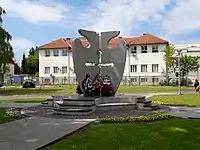
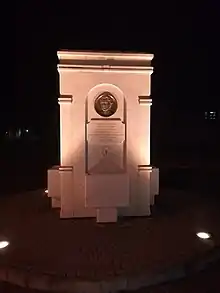
The town has a Serbian Orthodox cathedral dedicated to the Mother of God. There is also a mosque called the Džamija Begluk.
Sports
Local football club Kozara have played in the top tier of the Bosnia and Herzegovina football pyramid but spent most seasons in the country's second level First League of the Republika Srpska.
Economy
The following table gives a preview of total number of registered people employed in legal entities per their core activity (as of 2018):[6]
| Activity | Total |
|---|---|
| Agriculture, forestry and fishing | 320 |
| Mining and quarrying | 4 |
| Manufacturing | 2,916 |
| Electricity, gas, steam and air conditioning supply | 171 |
| Water supply; sewerage, waste management and remediation activities | 234 |
| Construction | 267 |
| Wholesale and retail trade, repair of motor vehicles and motorcycles | 1,956 |
| Transportation and storage | 452 |
| Accommodation and food services | 543 |
| Information and communication | 71 |
| Financial and insurance activities | 114 |
| Real estate activities | 24 |
| Professional, scientific and technical activities | 323 |
| Administrative and support service activities | 77 |
| Public administration and defense; compulsory social security | 581 |
| Education | 840 |
| Human health and social work activities | 661 |
| Arts, entertainment and recreation | 62 |
| Other service activities | 222 |
| Total | 9,838 |
Notable residents
- Marko Marin, German footballer
- Zvjezdan Misimović, Bosnian footballer
- Vaso Čubrilović, politician and historian, member of Black Hand organisation and participant in the conspiracy to kill Archduke Franz Ferdinand of Austria.
- Veljko Čubrilović, member of Black Hand organisation
- Vlado Jagodić, former footballer, now manager
- Vinko Marinović, former Serbian footballer, now manager
- Tatjana Pašalić, poker presenter
- Nordin Gerzić, Swedish footballer
- Alojzije Mišić, Roman Catholic bishop
- Branko Grahovac, football goalkeeper
- Atif Dudaković, Bosnian war-time army general
- Nazif Hajdarović, footballer
- Ratko Varda, basketball player
- Milan Janković, footballer
- Miodrag Latinović, retired footballer
- Zlatko Janjić, footballer
- Ozren Perić, footballer
- Safet Halilović, politician
- Ognjen Ožegović, Serbian footballer, European U-19 champion
- Goran Zakarić, Bosnian footballer
- Sergej "Mandarina" Milinovic, a final boss of Gradiska
- Amar Hrnjić Bosnian footballer
- Kristajan Zelonka Serbian footballer
- Miloš Stanišljević Serbian local resident from Turjak
International relations
Twin towns and sister cities
 Kavala, Greece (1994)
Kavala, Greece (1994) Ćuprija, Serbia (1994)
Ćuprija, Serbia (1994) Negotino, North Macedonia (2006)
Negotino, North Macedonia (2006) Montesilvano, Italy (2018)
Montesilvano, Italy (2018) Palilula, Serbia (2019)
Palilula, Serbia (2019) Zubin Potok, Kosovo (2021)[lower-alpha 1]
Zubin Potok, Kosovo (2021)[lower-alpha 1]
Partnerships
Gradiška also cooperates with:[8]
 Banja Luka, Bosnia and Herzegovina (2016)
Banja Luka, Bosnia and Herzegovina (2016) Bihać, Bosnia and Herzegovina (2016)
Bihać, Bosnia and Herzegovina (2016) Bijeljina, Bosnia and Herzegovina (2016)
Bijeljina, Bosnia and Herzegovina (2016) Bosanska Krupa, Bosnia and Herzegovina (2016)
Bosanska Krupa, Bosnia and Herzegovina (2016) Cazin, Bosnia and Herzegovina (2016)
Cazin, Bosnia and Herzegovina (2016) Čelinac, Bosnia and Herzegovina (2016)
Čelinac, Bosnia and Herzegovina (2016) Doboj, Bosnia and Herzegovina (2016)
Doboj, Bosnia and Herzegovina (2016) Kozarska Dubica, Bosnia and Herzegovina (2016)
Kozarska Dubica, Bosnia and Herzegovina (2016) Foča, Bosnia and Herzegovina (2016)
Foča, Bosnia and Herzegovina (2016) Goražde, Bosnia and Herzegovina (2016)
Goražde, Bosnia and Herzegovina (2016) Gračanica, Bosnia and Herzegovina (2016)
Gračanica, Bosnia and Herzegovina (2016) Gradačac, Bosnia and Herzegovina (2016)
Gradačac, Bosnia and Herzegovina (2016) Kalesija, Bosnia and Herzegovina (2016)
Kalesija, Bosnia and Herzegovina (2016) Konjic, Bosnia and Herzegovina (2016)
Konjic, Bosnia and Herzegovina (2016) Maglaj, Bosnia and Herzegovina (2016)
Maglaj, Bosnia and Herzegovina (2016) Modriča, Bosnia and Herzegovina (2016)
Modriča, Bosnia and Herzegovina (2016) Mostar, Bosnia and Herzegovina (2016)
Mostar, Bosnia and Herzegovina (2016) Novi Grad, Bosnia and Herzegovina (2016)
Novi Grad, Bosnia and Herzegovina (2016) Odžak, Bosnia and Herzegovina (2016)
Odžak, Bosnia and Herzegovina (2016) Orašje, Bosnia and Herzegovina (2016)
Orašje, Bosnia and Herzegovina (2016) Prijedor, Bosnia and Herzegovina (2016)
Prijedor, Bosnia and Herzegovina (2016) Prnjavor, Bosnia and Herzegovina (2016)
Prnjavor, Bosnia and Herzegovina (2016) Sanski Most, Bosnia and Herzegovina (2016)
Sanski Most, Bosnia and Herzegovina (2016) Srebrenik, Bosnia and Herzegovina (2016)
Srebrenik, Bosnia and Herzegovina (2016) Šamac, Bosnia and Herzegovina (2016)
Šamac, Bosnia and Herzegovina (2016) Teslić, Bosnia and Herzegovina (2016)
Teslić, Bosnia and Herzegovina (2016) Tešanj, Bosnia and Herzegovina (2016)
Tešanj, Bosnia and Herzegovina (2016) Tuzla, Bosnia and Herzegovina (2016)
Tuzla, Bosnia and Herzegovina (2016) Vareš, Bosnia and Herzegovina (2016)
Vareš, Bosnia and Herzegovina (2016) Velika Kladuša, Bosnia and Herzegovina (2016)
Velika Kladuša, Bosnia and Herzegovina (2016) Žepče, Bosnia and Herzegovina (2016)
Žepče, Bosnia and Herzegovina (2016) Živinice, Bosnia and Herzegovina (2016)
Živinice, Bosnia and Herzegovina (2016) Laktaši, Bosnia and Herzegovina (2018)
Laktaši, Bosnia and Herzegovina (2018) Čačak, Serbia (2018)
Čačak, Serbia (2018) Herceg Novi, Montenegro (2018)
Herceg Novi, Montenegro (2018) Hersonissos, Greece (2018)
Hersonissos, Greece (2018) Labin, Croatia (2018)
Labin, Croatia (2018) Nova Gorica, Slovenia (2018)
Nova Gorica, Slovenia (2018) Ragusa, Italia (2018)
Ragusa, Italia (2018) Shkodër, Albania (2018)
Shkodër, Albania (2018) Tiranë, Albania (2018)
Tiranë, Albania (2018) Daruvar, Croatia (2020)
Daruvar, Croatia (2020) Lipik, Croatia (2020)
Lipik, Croatia (2020) Jesi, Italia (2020)
Jesi, Italia (2020) Marche, Italia (2020)
Marche, Italia (2020) Mošćenička Draga, Croatia (2020)
Mošćenička Draga, Croatia (2020) Kotor, Montenegro (2020)
Kotor, Montenegro (2020) Tepelenë, Albania (2020)
Tepelenë, Albania (2020)
Notes
- As Serbia, because Bosnia and Herzegovina does not recognize Kosovo.
References
- the official web site of the municipality Archived 2020-09-27 at the Wayback Machine Gradiška/Градишка.
- "Systemic census of municipalities and populated places of Bosnia and Herzegovina" (PDF). Sarajevo: Agency for Statistics of Bosnia and Herzegovina. 2013. p. 7. Archived from the original (PDF) on 5 March 2016. Retrieved 16 July 2015.
- "Preliminary results of the 2013 Census of Population, Households and Dwellings in Bosnia and Herzegovina" (PDF). bhas.ba. Sarajevo: Agency for Statistics of Bosnia and Herzegovina. 5 November 2013. p. 8. Retrieved 16 July 2015.
- Стојан Бијелић. Машићка буна. Врбаске новине бр. 107 ст. 5, 1933. (извор)
- :: Www.Gradiskasela.Net :: Archived 2009-09-25 at the Wayback Machine
- "Cities and Municipalities of Republika Srpska" (PDF). rzs.rs.ba. Republika Srspka Institute of Statistics. 25 December 2019. Retrieved 31 December 2019.
- "Побратимски градови". gradgradiska.com (in Serbian). Gradiška. 2021-04-24. Retrieved 2021-04-24.
- "Пaртнeрски градови / oпштинe". gradgradiska.com (in Serbian). Gradiška. 2021-04-24. Retrieved 2021-04-24.
